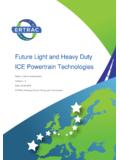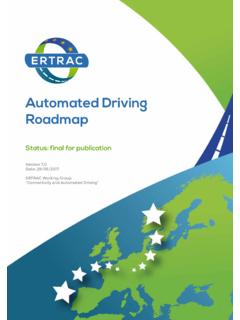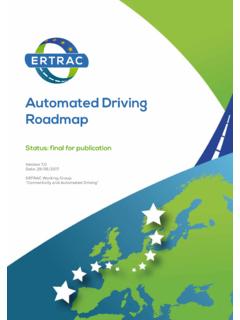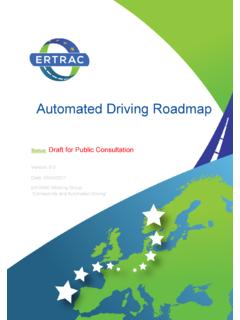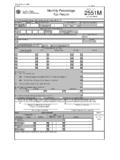Transcription of Automated Driving Roadmap - ertrac.org
1 Automated Driving Roadmap Status: final for publication Version Date: 29/05/2017. ERTRAC Working Group Connectivity and Automated Driving . Automated Driving Roadmap ACKNOWLEDGEMENTS: As a European Technology Platform, ERTRAC gathers experts from the industry, research providers and public authorities. This Roadmap was prepared by the Working Group Connectivity and Automated Driving , under the leadership of four co-leaders: Armin Graeter (BMW), Mats Rosenquist (Volvo Group), Eckard Steiger (Bosch), and Risto Kulmala (Finnish Transport Agency).
2 The first Automated Driving Roadmap of ERTRAC was issued in July 2015 and requested a complete update to cope with the many developments that happened since then. This new 2017 version presents updated definitions and development paths, an updated list of EU and international activities, and an extended list of R&D challenges. The following European projects, funded by Horizon 2020, have provided extensive support for the realisation of this Roadmap : FUTURE-RADAR (coordinated by AVL). SCOUT (coordinated by VDI/VDE-IT).
3 CARTRE (coordinated by ERTICO ITS Europe). 2. TABLE OF CONTENTS. 1. Scope and Objectives 4. 2. Common Definitions 5. Levels of Automation 5. Road definitions 6. Current systems Levels 0 and 1 6. Systems for Automated Passenger Cars 6. Systems for Automated Freight Vehicles 8. Urban Mobility Vehicles 10. 3. Development paths 12. 4. EU and international initiatives 16. European research projects 16. European initiatives 17. EU Member States initiatives 22. Initiatives around the world 28. 5. Key Challenges and Objectives 36.
4 User awareness, users and societal acceptance and ethics, driver training 37. Policy and regulatory needs, European harmonisation 37. Socio-economic assessment and sustainability 38. Safety validation and roadworthiness testing 38. New mobility services, shared economy and business models 38. Big data, artificial intelligence and their applications 39. Digital and physical infrastructure 40. In- vehicle technology enablers 40. Production and industrialisation 41. Human Factors 41. Connectivity 42.
5 6. Recommendations for Horizon 2020 Work Programme 2018-2020 43. 7. Annex 49. Common Definitions: current systems Levels 0 and 1 49. List of European funded projects addressing Connected and Automated Driving 51. 3. Automated Driving Roadmap 1. SCOPE AND OBJECTIVES. The main objective of the ERTRAC Roadmap is to provide a joint stakeholders view on the development of Automated Driving in Europe. The Roadmap starts from common definitions and a listing of available technologies, and then identifies the challenges for the implementation of higher levels of Automated Driving functions.
6 Development paths are provided for the different categories of vehicles. The Key Challenges identified should lead to efforts of Research and Development: ERTRAC calls for pre-competitive collaboration among European industry and research providers. The key role of public authorities is also highlighted: for policy and regulatory needs, with the objective of European harmonisation. Note about Connectivity: the scope of this Roadmap is by purpose limited to not cover all aspects of connectivity in Transport.
7 Connectivity will be addressed only when it is used to support the automation of Driving functions: Why Automated Driving ? Automated Driving is seen as one of the key technologies and major technological advancements influencing and shaping our future mobility and quality of life. The main drivers for higher levels of Automated Driving are: Safety: Reduce accidents caused by human errors. Efficiency and environmental objectives: Increase transport system efficiency and reduce time in congested traffic by new urban mobility solutions.
8 Also, smoother traffic will help to decrease the energy consumption and emissions of the vehicles. Comfort: Enable user's freedom for other activities when Automated systems are active. Social inclusion: Ensure mobility for all, including elderly and impaired users. Accessibility: Facilitate access to city centres. Automated Driving must therefore take a key role in the European Transport policy, since it can support several of its objectives and societal challenges, such as road safety, congestion, decarbonisation, social inclusiveness, etc.
9 The overall efficiency of the transport system can be much increased thanks to automation. Moreover, Automated Driving should be understood as a process taking place in parallel and possibly in integration with other important evolution of road transport: the electrification of the powertrains, and the multiplication of mobility offers, especially shared mobility concepts. This Roadmap for Automated Driving therefore contributes to the long-term vision of ERTRAC for the transport system. In one sentence: in 2050, vehicles should be electrified, Automated and shared.
10 4. 2. COMMON DEFINITIONS. Levels of Automation ERTRAC acknowledges the definitions of SAE J3016 defining the Levels of Automated Driving . Their latest version shall be used, after the revision adopted in September 2016, as accessible on: The figure below is a summary of these definitions and can be used for visual presentations, but experts shall always refer to the full standard text. Figure 1: SAE Levels of Driving Automation for On-Road Vehicles (September 2016, copyright SAE). Note: the definition of the level 5 of automation is still the object of confusion and different interpretations, in particular in the media and in public institutions.

